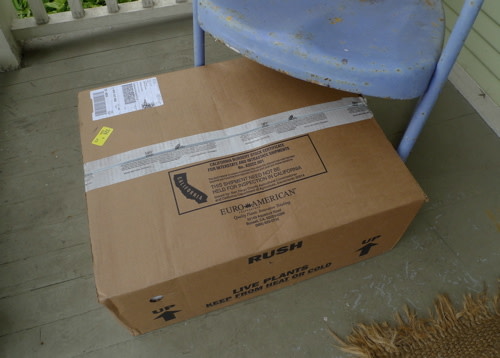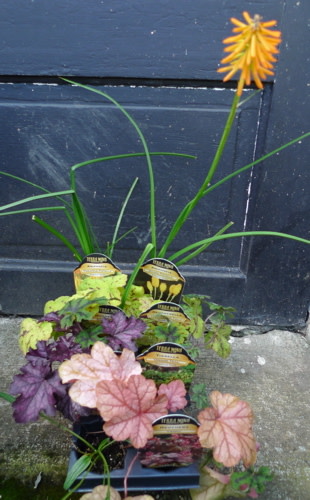I Know It’s Spring…

One fun facet of my job is that I am asked to trial plants every spring. Last week, I received a huge box of annual flowers and some shrubs in the mail from Proven Winners.
It’s always an exciting moment to cut open that box and find out what’s inside! This year, the list included some perennial plants: Echinacea ‘Little Annie’, Hemerocallis ‘Going Bananas’, and Hosta ‘Autumn Frost’; a couple of shrubs (Spiraea Double Play Gold and Double Play Artist; and a bounty of annual flowers: Verbena Superbena Royale Iced Cherry and Superbena Royale Peachy Keen, plus Calibrachoa Superbells in three varieties: Cherry Star, Sweet Tart and Grape Punch.

The names are silly – there’s nothing goofier than having to say, "Boy, I sure do like ‘Going Bananas.’" But they don’t ask me what to name the plants, do they?
And if the Proven Winners box wasn’t enough, the same evening at a party, I had the pleasant surprise of receiving a sampler of brand-new perennials from Dan Heims of Canby wholesaler Terra Nova Nursery.

The tray pack contains eight perennial plant plugs: two Kniphofia: Pineapple Popsicle and Mango Popsicle (a luminescent greenish-yellowish-orange – I already love the color); two Heucherella: Solar Power and Yellowstone Falls; two Heuchera: Vienna and Blackberry Crisp; a Tiarella called Oregon Trail; and one apparently fabulous new Echinacea which is in a heretofore unknown color. (Dan wouldn’t reveal what color!)
Most of these plants will go in pots and in the ground, for trial under some of the harshest conditions imaginable: my own garden. Since I’m busy with my clients’ gardens these days, my own garden is often sorely neglected. Other plant samples will go into my clients’ gardens, where I will monitor them all season to see how they do under different watering regimes and light conditions.
At the end of the year, I take my notes and review my photos to see which plants will become my garden compatriots and which won’t.
I have come away from these trials with some valuable information.
Last year, I trialled some fantastic annuals for Proven Winners. By season’s end, I had grown fond of Lobularia ‘Snow Princess’ (Snow Princess sweet alyssum), which flowered all season, from the moment I planted it until frost stopped it in November. It didn’t self sow (which is good, as Alyssum burn out after seeding and this one is sterile) and was marvelously bouffy, not straggly as the species can be. Like all sweet alyssum, Snow Princess is one of the best nectar sources for beneficial insects.
I fell in love with a strange and marvelous little "spiller" annual I’d never even heard of: Mecardonia Gold Dust. The gloriously bright, egg-yolk colored flowers on this plant only stopped in mid-summer when I forgot to water it for a week. Once watered and sheared back, it was flowering again within a few weeks.
Another favorite of mine from last year’s batch was Verbena Superbena Royale Chambray, which flowered non-stop and whose handsome denim blue color worked so well with other purple and blue flowers I had planted. Verbenas are attractive to butterflies, too.
I also learned that not all yellow heucheras are made alike. While Heuchera ‘Lime Marmalade’ has performed like a trouper in clients’ pots, retaining mostly flawless foliage all winter – even during the last two challenging winters – I have had trouble with the winter appearance of other gold-leafed heucheras I’ve tried. Not only do they half die down to the ground but they also develop unsightly foliar spotting that has to be removed right when you most need the foliage. I don’t bother with any yellow Heuchera now except Lime Marmalade.
{% display:image for:post image:3 align:right width:350 %}
I never had a chance to trial it before it came out, but I am a total fan of Helleborus ‘Hot Flash’, a Terra Nova introduction from several years ago. I use it in containers every winter, as it has the great combination of smoky purple-green flowers and amazing silver-marbled foliage with burgundy stems. There’s just nothing like it. And that’s a bad-ass name, too!
So there’s a real value to designers, to growers and to shoppers with these trials. We pass what we learn on to growers and they can work to overcome any problems in their breeding or acquisition programs, while giving them extra information they need to confidently sell plants that are uniformly successful with trial growers in different regions. Of course the consumer benefits from more information, too. And honestly, I might not ordinarily buy new annuals to try – especially with such silly names – so being sent a variety like this forces me to try out plants I might not ordinarily use. Everyone benefits!
